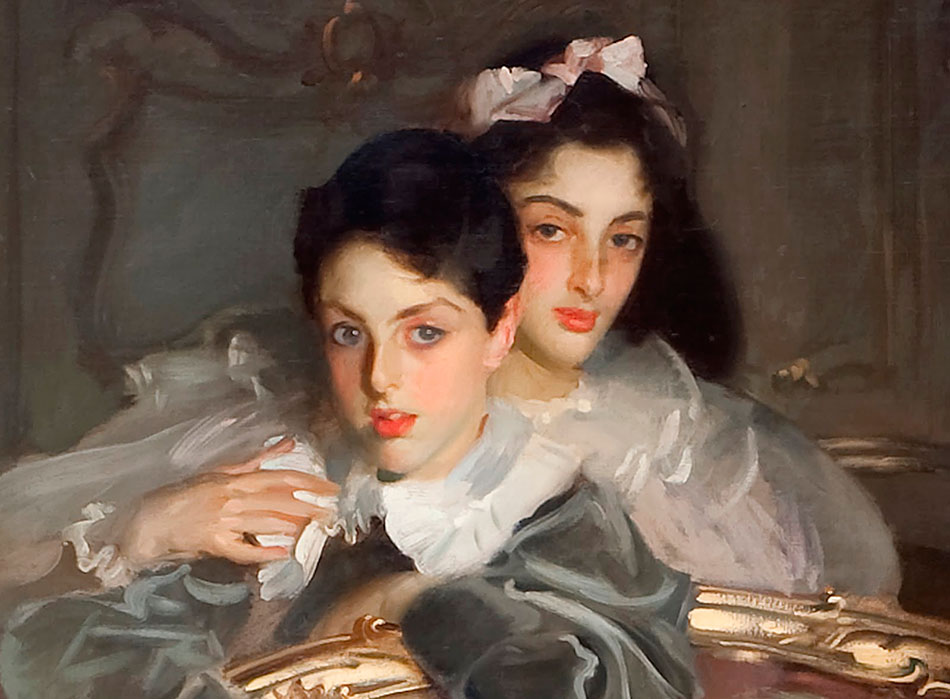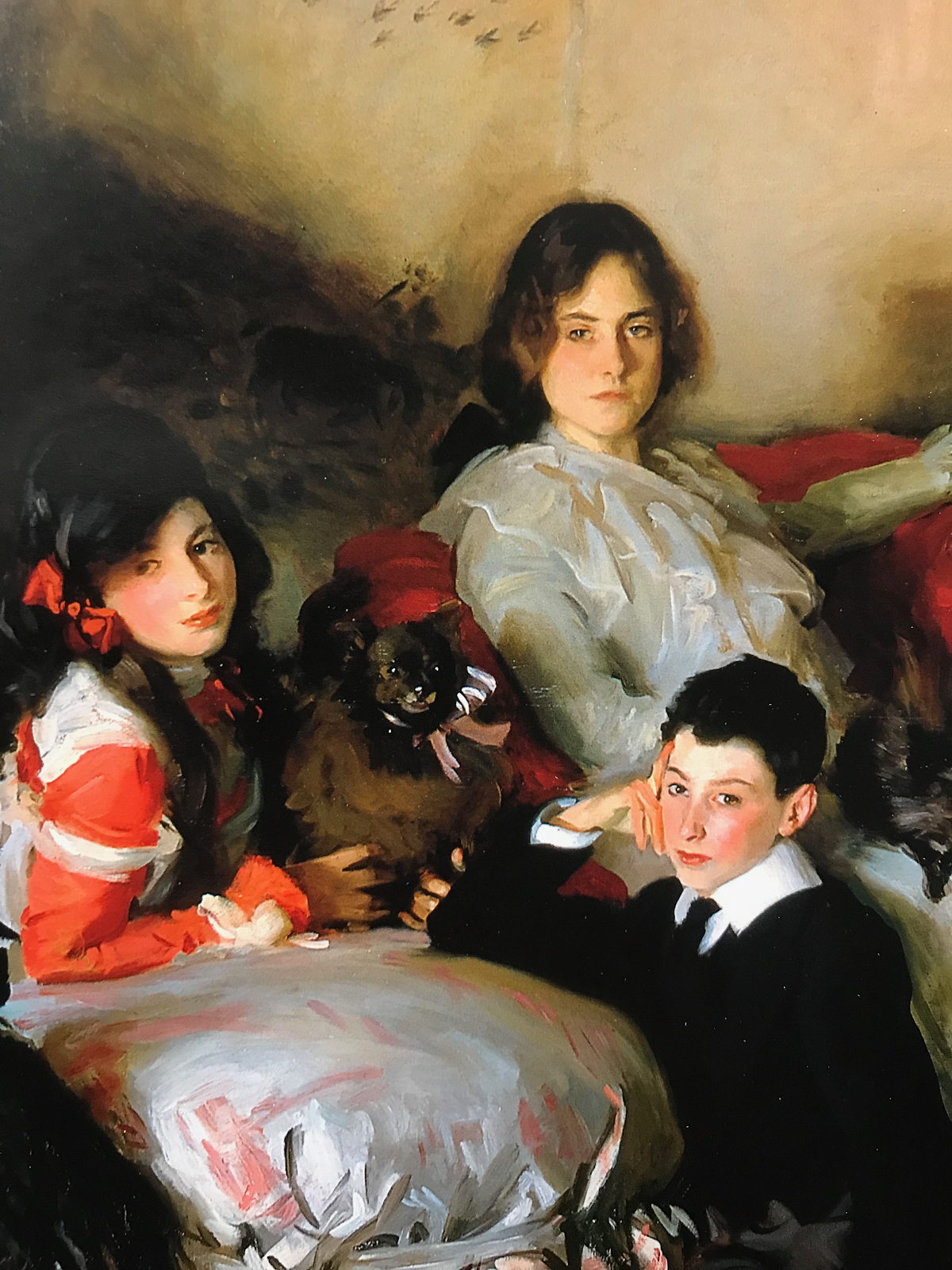Aurelia Benton stood in front of the Sargent portrait, amazed at both its subtlety and intensity. She almost had to look away, the women in the painting were asking too much of her. Their directness was one of confidence - it showed every bit of the elegance of these patrician aristocrats - but it was also intensely intimate. They would never be distracted, disturbed by their children or the maid. The moment was theirs - the women’s and Aurelia's.
There was no way to describe the feeling of looking at this portrait. Happiness? Joy at seeing such a masterpiece? Finality, a kind of closure of her own feelings of insecurity, intimidation by so many impossibly insoluble problems and so little time left to consider them? Or simply peace, a settling of her mind into a comfortable living room appointed with Townsend chairs, Revere silver, a bouquet of blue chrysanthemums, a Tiffany lamp on the Chippendale settee.
The women in the paintings despite their intensity and directness were approachable. They would not be hard women. Their demands were not selfish but exploratory - intimacy for them and the observer.
Aurelia wanted to be those women, seated in their Victorian salons, quiet, determined, and peacefully resolute. Perhaps the maid was waiting for the session to finish before she brought in tea for master and subject. Perhaps the children were tired of being quiet and wanted to play.
This was Aurelia's Saturday at the National Gallery, an increasingly necessary respite - refuge, actually - from her work which despite its good intentions and social promise was as dead and dry as November leaves. It was relentlessly focused and practical. Charts showing differential rates of social mobility by race, graphs charting the temperatures of the North Atlantic, policy papers tracing the history of the black man from Angolan tribal slavery to the Americas, Jim Crow, discrimination, and perpetual marginalization.
The sentiment in her Adams Morgan office was serious, angrily so. The climate was changing for the worse and still America dallied and demurred. The black man, now over 150 years after Emancipation, still groped and grasped his way out of the dark hole of prejudice. The lesbian, desperate for the unalloyed freedom to love women, was still cloistered in the jackboots-and-flannel enclaves of Bernal Heights. The country was owned by white racist, supremacist, capitalist idolaters. There was no room for levity, no room for anything but absolute defiance of the status quo.
As much as Aurelia supported these causes of social reform, she was increasingly depressed. There might be no cause for humor or even irony when the problems were so persistent and so severe, but why was there no inspiration? No sense of artistic perspective, and most tellingly no God.
She moved to a series of Renaissance paintings depicting the life of Christ. Every one of them had inspiration and passion. Fra Angelico's 'Crucifixion' even in its simple late Medieval style conveyed the grief of those weeping at the foot the cross, the suffering of the tortured, dying Jesus, and the hope of the coming Resurrection. Fra Angelico had captured in this one painting what it meant to be human and what it was to be divine.
Aurelia's work at the office was to prepare handouts to the media for coverage of climate change, racial prejudice, and the conservative denial of gay and transgender rights. She had learned to craft her materials to fit the programming ethic of MSNBC and CNN - stories that featured black, Latino, and gay men and women overcoming prejudice but did so to elicit sympathy, compassion, and righteous anger. She kept to the secular, practical, politically demanding aspects of the problem and never varied.
She stood before Giorgione's Holy Family - like Michelangelo's work, a resonant statement of motherhood and fatherhood. The decor is simple but elegant, the ruins of a city in the far background. The colors are bright but the expressions on Mary and Joseph peaceful and quiet. The painting is classically ordered, symmetrical, and perfectly aligned.
It is one thing to be determined, single-minded and deliberate - a reasonable approach to resolving thorny issues for which you have a passionate commitment - but another altogether to eliminate all but the most direct, obvious, and predictable aspects of them. The Holy Family is not simply a piece of the Christian puzzle, it is central to the faith; and by extension to all families. Communities which dismiss the idea of family as the center of communal life and an important spiritually regenerative force are not whole, and to ignore this critical aspect of dysfunctionality is irresponsible.
Aurelia loved her Saturdays at the National Gallery, brought her lunch and sat on the steps overlooking the Mall, and decided where to go next. The exhibit of Anselm Kiefer's wall-sized tableaux was stunning in its scope and breadth. Many people have the same response to his paintings as to those of Sargent - they are too personal, too intimate, and too demanding regardless of their abstraction and darkness. They ask the viewer to examine the world emotionally, not logically; to feel something about his receding, cold landscapes. The observer at first studies the paintings for something familiar - a meme, a popular metaphor, a clue to meaning, but then is left with an overwhelming feeling of loss and despair.
There is no way to tangibly feel real spiritual sentiment - it is too subtle, too removed, too personal. Attending mass or a spirited revival doesn't do it - the trappings and rituals are too obvious - so introducing themes and reflections that are reminders of place, being, and purpose is not easy. Artists do it, but few people stand in front of their works like Aurelia did; and bringing them to the ghetto would make no sense. A museum is like a church, but without the ceremony, and more like a monastery with a few holy icons on the walls of the chapel.
There was no way to bring Aurelia's particular sensibilities to her work. If she stayed, it would have to be the same algorithmic prescriptions, the same angry, prepared responses, the same reflexive hatreds and preferences. There was clearly no room for art or God in the progressive canon, and the best place for her was on her own.








No comments:
Post a Comment
Note: Only a member of this blog may post a comment.